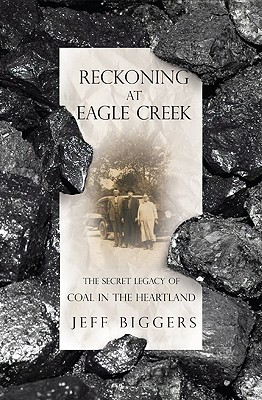Modern coal extraction methods in the US today continue a legacy of deception and destruction that the vast majority of Americans are entirely unaware of. In recent years, the environmentally devastating practice of Mountain Top Removal (MTR) has become a flashpoint for an industry under increasing scrutiny for the adverse impacts on health, welfare and the environment directly attributable to coal mining and consumption.

Historically, coal mining has been fraught with labor issues and and dangers to life and property both direct and indirect, MTR is the most extreme example of an industry which from cradle to grave poses a danger to the ecosystems on every continent and a stable global climate system. After publishing a landmark study of MTR in January's Science, some of the nation's leading scientists called on the Obama administration to permanently ban the practice of MTR. Their peer-reviewed paper entitled Mountaintop Mining Consequences concluded that MTR causes irrevocable damage to the environment destroying entire ecosystems and invariably results in life threatening endangerment to humans. The resulting environmental degradation is so severe that remediation is impossible.
In his exhaustively researched illuminating new book, Reckoning at Eagle Creek: The Secret Legacy of Coal in the Heartland, HuffPost blogger Jeff Biggers, whose family heritage was impacted by surface mining in Illinois, exposes the dark secrets and practices which grew the coal mining industry into a central position in delivering the electricity for a nation -- including legalized slavery in the land of Lincoln. The same slogans which were first coined over 100 years ago lauding the value of "clean coal" continue to be spun today to a public which now as then, consumes the power and for the most part buys into a greenwashed picture of an inherently dirty industry as essential to preserving the American way of life.
The following interview took place as Jeff Biggers is receiving critical acclaim and speaking on a national tour.
JC: In your book, it is surprising that the campaign for "clean coal" was initiated in the late 1800's and continues today.
JB: In the 1890s, a young coal peddler and Democratic Party activist from Chicago by the name of Francis Peabody took out ads for "smoke-free clean coal." And while the Peabody family ran the company into the ground by the 1950s, the Peabody franchise name went on to become the largest coal company in the world. Over the next century, whenever the coal industry encountered an image or environmental problem -- from workplace safety and black lung, to strip-mining, processing, and the burning of coal and the myriad problems of sulfur, mercury and CO2 emissions -- it has simply trotted out this marketing slogan. And the devastation from coal mining and burning continues.
JC: As you dug into your family's history in Illinois coal country, were you surprised by what you discovered in terms of legal slavery in the Lincoln state?
JB: The coal industry, like tobacco and cotton, was launched on the backs of African and African American slaves in Virginia in the early 1700s. By the 1850s, over 3,000 slaves worked in the combined coal and salt productions in the Kanawha River Valley alone, in modern-day West Virginia. North of the Mason-Dixon Line, the entangled destiny of the ancient salt and coal basins shared the modern schemes of slavery. In fact, black slaves arrived in the coal mines in the Illinois Country nearly half a century before their counterparts dug the first pits in Virginia. Over five hundred black slaves from Haiti floated up the Mississippi River and disembarked on the Illinois shores at Fort Chartres in 1722. to dig coal for the French. Black slaves continued to mine coal in Illinois for the next century.
Our Illinois constitution in 1818 outlawed slavery with one exception: Legal slavery was allowed in the salt works that employed the same slaves to dig out the coal for the furnaces. Recognizing that more than one-third of the state's tax revenues came from the salt wells fueled by coal, the anti-slavery advocates capitulated to the demands of the slave-owning companies. In essence, the inalienable rights of man in other free states came in a distant second to the power of the tax revenues for Illinois's emancipationists.
My family, as backwoods Baptists in Eagle Creek, took on the slave owners and coal miners in a determined anti-slavery movement. We've been fighting Big Coal ever since.
The entwined roots of black slavery and coal mining remain a cautionary tale for today: Do commerce and profit for outside companies overrule our nation's commitment to human rights and environmental justice?
JC: It would seem that early on the evolution of Peabody and other coal giants, they made the deliberate effort, successfully, to externalize the costs of coal extraction and consumption, and those same models continue to be used today.
JB: Despite the fact that black lung disease, which has killed over 250,000 miners, was diagnosed in 1831, our government and coal companies did nothing to deal with it until 1968. And coal companies have effectively defaulted on their own requirements to fund the program, resulting in billions of tax dollars from our own pockets. Likewise, the Abandoned Mines program has cost US taxpayers billions of dollars. According to the National Academy of Scientists, the external costs of coal total more than $60 billion.
And yet, we still provide billions of dollars in subsidies to the coal industry.
This lethal combination of denial and abandonment has made the coal industry was one of the most dangerous, reckless and costly endeavors in industrial history.
So, when the Obama administration starts using billions of dollars to jumpstart the chimera of carbon capture and storage, literally writing checks with our taxpayer funds to Mr. Peabody and his FutureGen giants again, I can't help but think we have learned very little from history.
It's time to bring the welfare party of Big Coal to an end, and put those same subsidies and investments into clean energy programs.
JC: What promising signs if any do you see for an end to what many consider to be the illegal practice of mountaintop removal in the US? Why do the coal companies like Massey and Peabody continue to enjoy local support in the most impoverished communities in the US?
JB: The only people who support mountaintop removal or other forms of strip-mining are those on the company's payroll. Coal miners, and their families, understand better than anyone that strip-mining strips jobs don't lead to any sustainable future. Since the 1980s, we've lost more than 60 percent of our coal mining jobs in most coalfield areas due to the heavy mechanization of strip-mining and longwall mining; the coalfield communities rank among those counties with the highest unemployment, poverty and worst health care factors, while billions and billions of dollars of coal have been trained and trucked away. When an outside corporation comes in, controls the mineral rights, and is able to put a stranglehold on any diversification of the economy, subjecting the coalfield areas to the boom-bust whims of a volatile economy, there is nothing but despair and hopelessness that remains.
My book looks at the history of the coal mining industry and the fact that regulations have historically failed or been circumvented, again and again. The Obama administration needs to recognize this history and abolish mountaintop removal, and not allow the regulatory nightmare to continue, because there is a staggering human and environmental cost in the process.
Human lives have now become an accepted part of the external cost, and if Americans knew the extent of the real suffering and devastation in our coalfield areas, I think we would move quickly to launch a just transition to other forms of clean energy.
Coal miners, like all Americans, want to live in beautiful and sustainable communities, with a future for their children. This means we must insist that coalfield communities who have served on the frontlines of our dirty energy policy for two centuries, get their fair share of clean energy jobs, and clean energy investments, not just the crumbs; that a "just transition" is planned for the coalfields, including a GI Bill for coal miners, with retraining and education, with massive reinvestment for clean energy manufacturing, weatherization and efficiency programs, and reforestation initiatives.
Al Gore and all green job and clean energy advocates must come to the coalfields and stand with our coal mining families today.
Bottom line: The coalfields -- and this includes the 26 states where we mine coal, not simply Illinois and Appalachia -- are ground zero in the climate change battle today. As long as we continue to pursue boondoggles like carbon capture and storage schemes, which will only increase coal mining production and the devastation in the coalfields, we will blindside any progress for a clean energy future.
Given the reality of climate destabilization, and the fact that nearly 40 percent of our CO2 emissions erupt from coal-fired plants, we need to commit to a coal free future if we are to survive as a planet -- and that begins in the coalfields.
We all live in the coalfields now.
